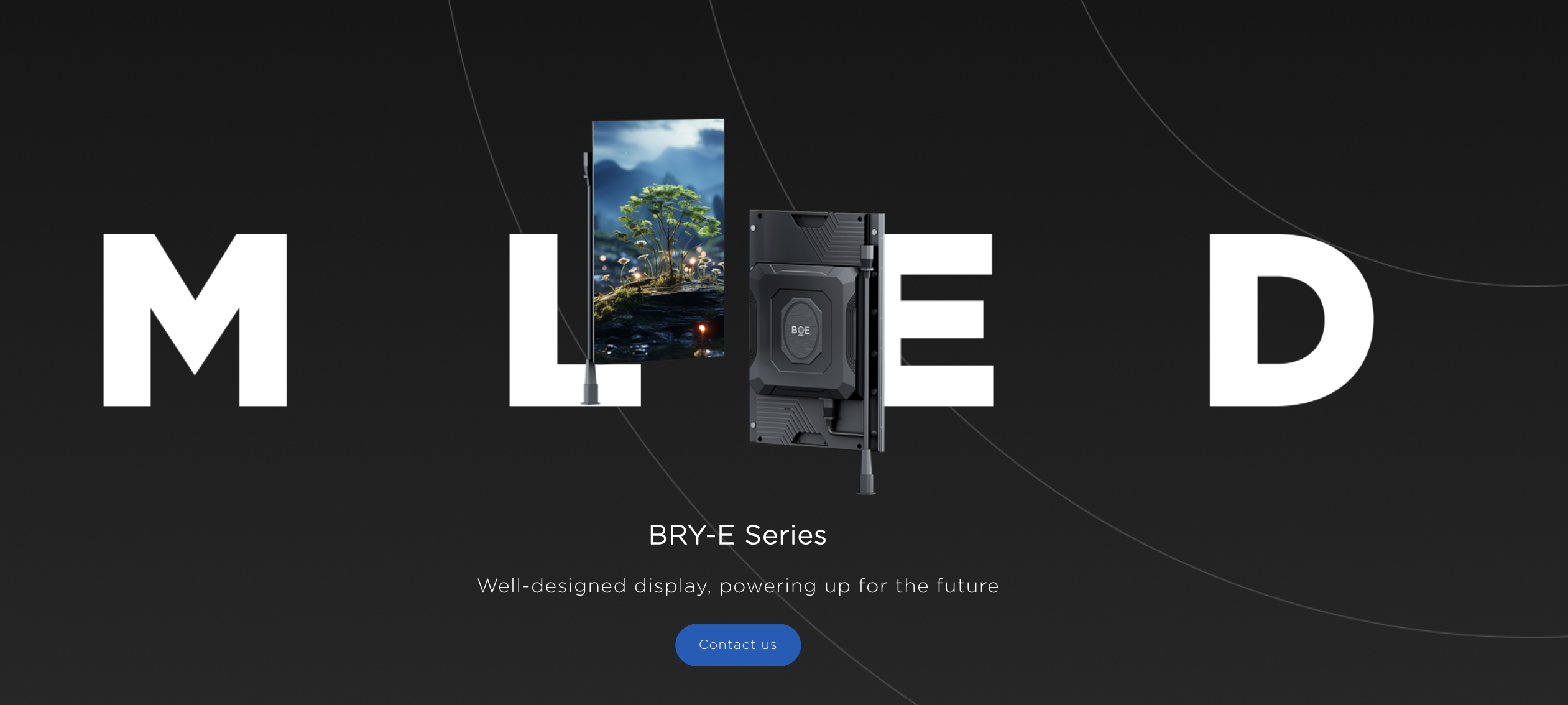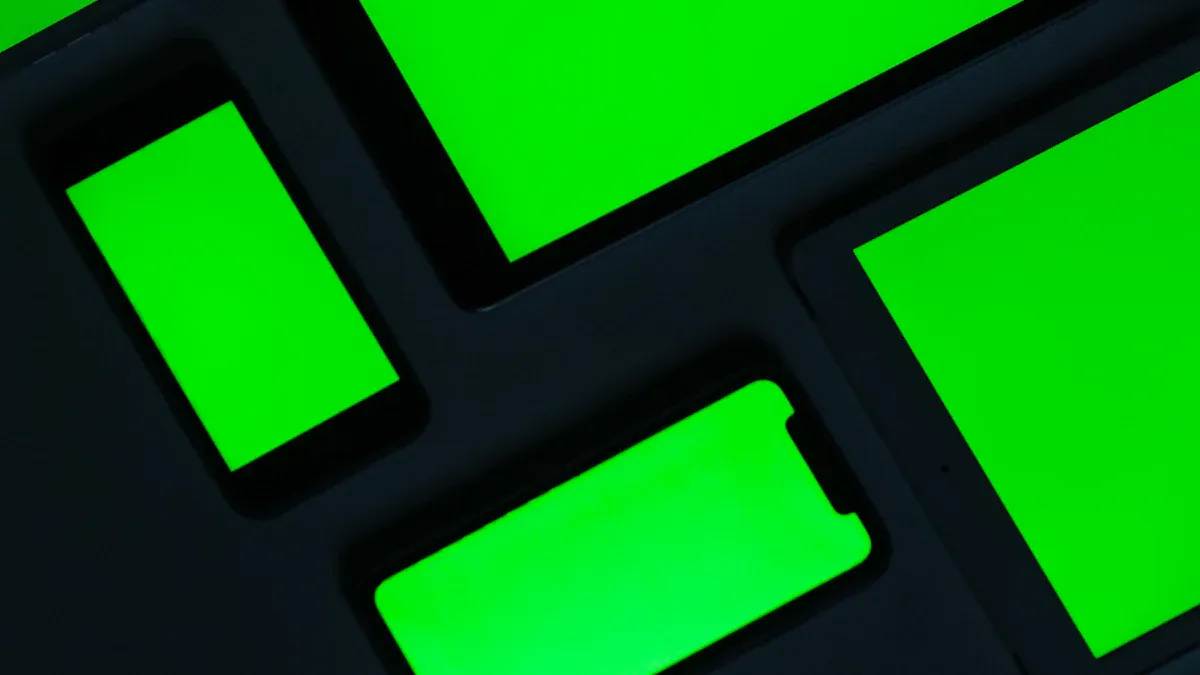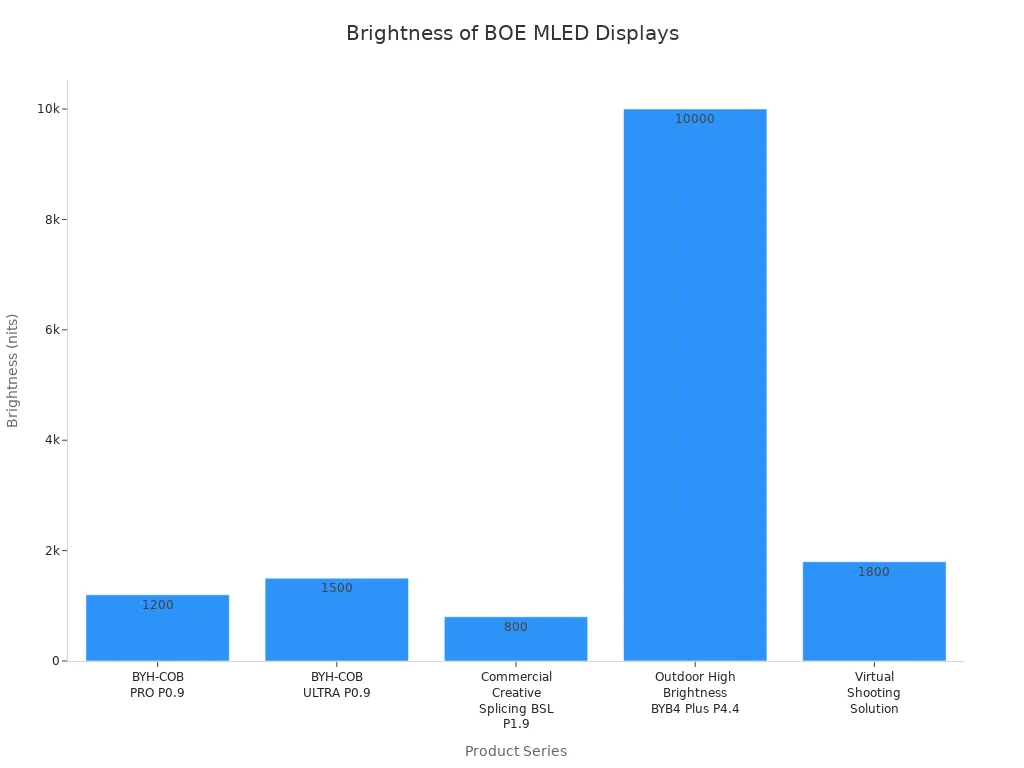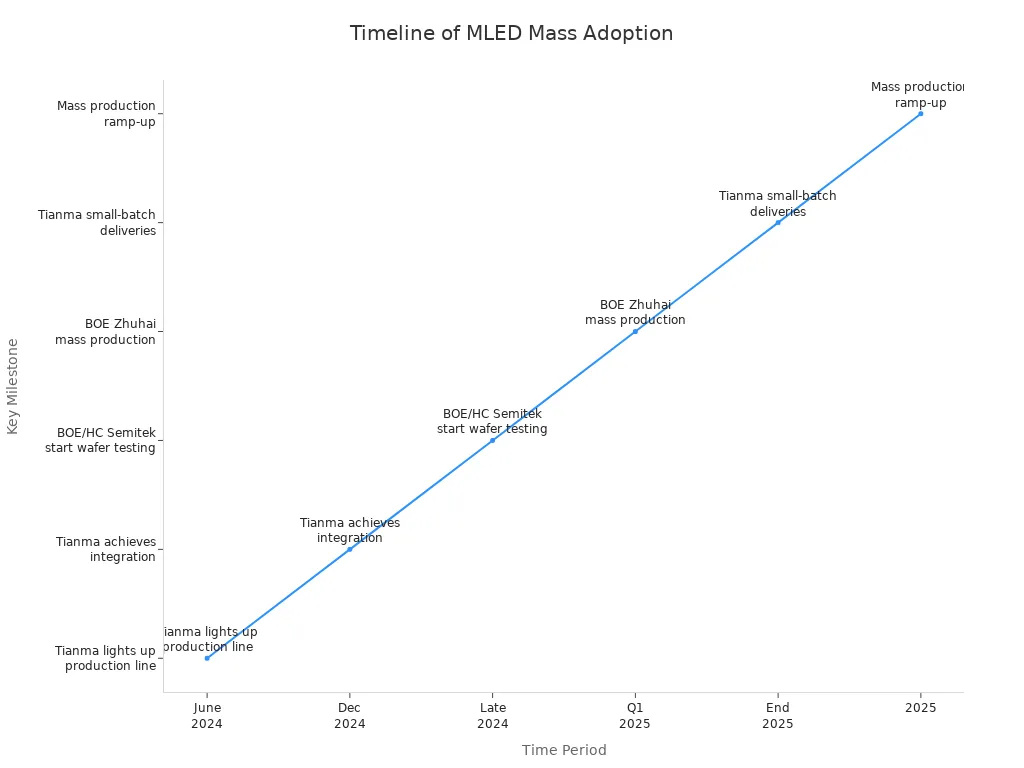What is MLED Technology?

MLED technology refers to advanced display solutions that use Mini-LED or Micro-LED as their core light source. This technology delivers outstanding brightness, wide color gamut, and long lifespan for a range of display applications.
The Mini-LED global market, predicted by SNS insider research, is expected to reach $10.19 billion by 2032, with growth driven by demand in consumer electronics and automotive displays.
Micro-LED is also forecasted to expand rapidly.Leading manufacturers have accelerated adoption, and strong policy support in China fuels industry growth. BOE stands out in the sector, ranking among the world’s top innovators with significant investments and patent leadership in MLED technology.
Key Takeaways
MLED technology uses Mini-LED and Micro-LED to create brighter, clearer, and longer-lasting displays than traditional screens.
Mini-LED improves LCDs by adding many tiny LEDs for better brightness and contrast, while Micro-LED uses tiny self-lighting pixels for perfect blacks and vivid colors.
MLED displays save energy and last longer, making them ideal for TVs, smartphones, cars, medical devices, and commercial screens.
Advanced packaging methods like Chip on Board and Chip on Glass help make MLED displays sharper, more reliable, and suitable for different uses.
MLED technology is growing fast and changing how we see screens, offering better image quality, energy efficiency, and flexible designs.
MLED Technology Overview

What is MLED?
MLED technology represents a breakthrough in next generation display technology, combining the strengths of Mini-LED and Micro-LED to deliver superior visual performance. MLED stands for Mini/Micro-LED, encompassing two advanced forms of LED-based display solutions. Mini-LED technology uses ultra-small LED lamp beads as a backlight for LCD panels, while Micro-LED technology features microscopic LEDs that act as self-emissive pixels. Both approaches redefine the standards for brightness, color accuracy, and energy efficiency in modern displays.
MLED technology has transformed the display industry by enabling higher brightness, deeper contrast, and longer lifespan compared to traditional LCD and OLED solutions. The adoption of MLED direct-view technology has accelerated across various sectors, including consumer electronics, automotive, and professional applications. Manufacturers have leveraged MLED technology to create displays that meet the demands of high dynamic range (HDR), wide color gamut, and ultra-fine resolution.
Recent advancements in MLED technology include hybrid drive systems, chip architecture innovation, and breakthroughs in mass transfer and chip integration. These developments have enabled pixel densities up to 1800 ppi, ultra-fast refresh rates, and significant reductions in power consumption. The integration of active matrix drive technology and high-speed interface chips has further enhanced the performance and reliability of MLED direct-view technology, making it a cornerstone of next generation display technology.
Note: MLED technology not only improves image quality but also supports modular and customizable display solutions, paving the way for flexible and scalable applications.
Mini-LED and Micro-LED
Mini-LED and Micro-LED represent two distinct yet complementary approaches within MLED technology. Both technologies offer unique advantages and address different application needs.
The following table highlights the key differences between Mini-LED and Micro-LED:
Feature/Aspect | Mini-LED Technology | Micro-LED Technology |
|---|---|---|
Definition | Advanced backlighting technology for LCDs using ultra-small LED lamp beads arranged densely. | Self-emissive display technology where each pixel is a microscopic LED emitting its own light independently. |
Light Emission | Uses backlight with full matrix zone dimming to control brightness in many small zones. | Each pixel emits light independently, no backlight needed. |
Pixel Size | Lamp beads are ultra-small but still larger than micro-LED pixels. | Pixels are micron-level in size (1-10 microns), much smaller than Mini-LED beads. |
Brightness & Contrast | Improves brightness and contrast over traditional LCDs by controlling many small backlight zones. | Achieves ultra-high brightness (up to 30x OLED), infinite contrast ratio with true blacks due to self-emission. |
Color Performance | Enhanced color and contrast, approaching or surpassing OLED in some aspects. | Exceptional color saturation, very accurate and vivid colors from pure RGB emission. |
Power Consumption | Lower power consumption than traditional LCD and OLED at lower brightness levels. | Extremely low power consumption, highly energy efficient. |
Lifespan | Longer lifespan than traditional LCD backlights but limited by backlight technology. | Very long lifespan, no organic materials so no burn-in or degradation over time. |
Additional Characteristics | Can suffer from blooming effects due to backlight zones; improves LCD displays. | Modular design possible; no organic materials; no burn-in; superior durability and customizable display sizes. |
Mini-LED technology enhances LCD panels by providing precise local dimming and higher brightness. It uses thousands of tiny LEDs as a backlight, allowing for more control over contrast and color accuracy. This approach reduces blooming and improves HDR performance, making it ideal for large displays, TVs, and monitors.
Micro-LED technology takes a different approach. Each pixel is a microscopic LED that emits its own light, eliminating the need for a backlight or color filters. This self-emissive structure enables perfect blacks, infinite contrast, and exceptional color saturation. Micro-LED displays achieve ultra-high brightness and energy efficiency, with pixel sizes as small as 1 micron. The modular nature of Micro-LED allows for customizable display sizes and shapes, supporting applications from AR/VR to automotive and wearable devices.
MLED direct-view technology leverages both Mini-LED and Micro-LED to deliver next generation display technology. Mini-LED technology provides a cost-effective solution for high-performance LCDs, while Micro-LED technology sets new benchmarks for image quality and durability. Both technologies support the development of ultra-thin, flexible, and energy-efficient displays.
The significance of MLED technology in the display industry continues to grow. Manufacturers have adopted advanced chip-on-board (COB) and chip-on-glass (COG) packaging, hybrid drive systems, and active matrix drive technology to push the boundaries of performance. These innovations have enabled MLED direct-view technology to achieve high refresh rates, precise local dimming, and superior color reproduction.
Industry leaders have demonstrated their commitment to MLED technology through product launches, patent achievements, and partnerships. At major industry events, BOE h have showcased world-first products powered by MLED technology, including ultra-fast gaming monitors, automotive HUDs, and professional-grade displays. Factories dedicated to MLED mass production have reached new milestones, supporting the global expansion of next generation display technology.
MLED technology stands at the forefront of display innovation, offering unmatched visual experiences and setting new standards for performance, efficiency, and reliability.
Micro LED and Mini LED Technology
Micro LED Features
Micro LED technology stands out as a self-emissive solution, where each pixel generates its own light. This approach eliminates the need for backlighting, resulting in displays with extremely high brightness and true blacks. Micro LED displays reach brightness levels up to 10,000 nits, making images vivid and clear even in bright environments. The contrast ratio is effectively infinite, as each pixel can turn off completely, producing deep blacks and sharp images. Energy efficiency is a hallmark of micro-led technology, with power consumption much lower than traditional LCD and OLED displays. Micro LED displays also offer rapid response times, supporting smooth video playback and immersive experiences. The use of inorganic materials ensures a long lifespan, with no risk of burn-in, which is a common issue in OLED vs Micro LED comparisons. Micro LED displays maintain color accuracy and saturation, providing an ultimate display solution for demanding applications.
Self-emissive pixels for true blacks and high contrast
Extremely high brightness, up to 10,000 nits
Superior energy efficiency and long lifespan
Fast response times for smooth motion
No burn-in risk, maintaining image quality over time
Mini LED Features
Mini LED technology uses much smaller LED chips, typically between 50 and 200 microns, allowing a higher density of LEDs in the backlight. This enables more local dimming zones, which improves contrast and produces deeper blacks in images. Mini LED displays achieve higher brightness levels and maintain full RGB color integrity, resulting in a wider color gamut. The increased number of dimming zones reduces blooming effects, enhancing image clarity. Mini LED displays are thinner and more power-efficient, as LEDs can be turned off in dark areas. This technology serves as a cost-effective bridge toward micro-led technology, offering many benefits of advanced displays while remaining accessible.
Smaller LED chips for higher density and more dimming zones
Improved contrast and deeper blacks
Higher brightness and better color quality
Reduced blooming and thinner display profiles
Enhanced power efficiency
Micro LED vs. Mini LED vs. Other Displays
Feature | Micro LED | Mini LED | OLED | LCD |
|---|---|---|---|---|
Brightness | Up to 10,000 nits | High | Moderate | Moderate |
Contrast Ratio | Infinite | High (with dimming) | Infinite | Limited |
Energy Efficiency | Very high | High | Moderate | Low |
Lifespan | Very long | Long | Shorter (burn-in) | Moderate |
Color Accuracy | Excellent | Very good | Excellent | Limited |
Response Time | Fast | Moderate | Fastest | Slowest |
Burn-in Risk | None | None | Yes | None |
Micro-led technology delivers the ultimate display solution by combining high brightness, energy efficiency, and long lifespan. Mini LED improves upon traditional LCD by offering better contrast and color, but it is not self-emissive like micro-led. OLED provides excellent color and contrast but faces burn-in and shorter lifespan. LCD remains cost-effective but lags in image quality and response time. The micro-led market status shows rapid growth as more industries seek the benefits of µled and micro-led displays for next-generation applications.
MLED Display Applications

Consumer Electronics
Micro LED and Mini LED technologies have transformed the consumer electronics landscape. Micro LED displays now power smartwatches, smartphones, tablets, and laptops, delivering exceptional image quality and energy efficiency. The consumer electronics segment leads the Micro LED market. This dominance results from the demand for lightweight, power-efficient, and high-performance screens in portable devices.
Mini LED direct-view televisions and Micro LED TVs have set new standards for home entertainment. These high-end displays offer deeper blacks, brighter whites, and vibrant colors due to independent LED control. Users experience higher brightness levels, improved contrast ratios, and enhanced color accuracy. Micro LED and Mini LED screens also provide durability, resisting burn-in and supporting longer lifespans compared to OLED. The flexibility of these technologies allows for thinner, lighter devices, making them ideal for mobile products.
Note: Mini LED, Micro LED and flexible displays are increasingly popular in wearables and AR/VR devices, offering high refresh rates, HDR support, and uniform illumination. These features reduce issues like clouding or light bleeding, ensuring a superior visual experience.
Product Type | Key Benefits with MINI-LED / MICRO-LED Technology |
|---|---|
Smartphones/Tablets | Superior image quality, energy efficiency, durability |
Laptops | High brightness, thin profile, long battery life |
Televisions | Deep blacks, vibrant colors, HDR, uniform illumination |
Wearables | Lightweight, flexible, high refresh rates |
Automotive and Medical
The automotive industry has rapidly adopted Mini LED and Micro LED displays for dashboards, infotainment systems, and heads-up displays. Luxury vehicles now feature Micro LED screens embedded into dashboards, including wood-grain finishes, providing innovative and subtle display solutions. These displays deliver high brightness and contrast, ensuring visibility under all lighting conditions and directly enhancing driver safety.
Micro LED technology offers a wide operating temperature range and superior luminance, making it reliable in harsh automotive environments. Mini LED backlighting improves contrast, reduces power consumption, and enables flexible form factors for central vehicle clusters. Micro LED emissive displays further enhance HDR performance and power efficiency, supporting advanced automotive applications.
In medical imaging, Micro LED displays support critical diagnostic needs. A 31-inch Micro LED display with advanced driving technology and anti-reflective surface treatments reduces glare and enhances image clarity both indoors and outdoors. These bezel-less screens offer super-wide viewing angles and seamless tiling for large-scale visuals. The result is ultra-high-definition image quality, high color saturation, and excellent ambient light contrast, which are essential for accurate medical diagnostics.
Safety and reliability remain top priorities in automotive and medical applications. Inorganic LEDs provide robustness, long lifespans, and stable operation under extreme conditions, making them ideal for these demanding sectors.
Commercial and Industrial
Commercial and industrial sectors increasingly rely on Mini LED and Micro LED direct-view LED displays for digital signage, control panels, and large-screen commercial displays. BOE’s ⍺-MLED technology, utilizing chip-on-glass (COG) and chip-on-board (COB) packaging, delivers superior image quality, uniformity, and thermal stability. These features enable finer pitch screens, ideal for high-detail visuals in advertising screens and command centers.
Key applications include:
Digital signage and advertising screens: Outdoor billboards, video walls, and dynamic marketing content benefit from high brightness and durability.
Control rooms and command centers: LED video walls provide real-time data visualization for industrial monitoring.
Transportation hubs: Airports and train stations use LED displays for passenger information.
Retail environments: Immersive and interactive displays attract customers and promote products.
Corporate spaces: Conference rooms and lobbies use LED display technology for presentations and branding.
COB technology bonds RGB chips directly onto PCBs, enhancing durability and resistance to damage. Pixel pitches below 1.0mm allow for high-resolution displays suitable for detailed commercial and industrial applications. Lightweight and thin modules simplify installation and transportation, reducing deployment time and costs. Improved heat management and outdoor resilience ensure longer lifespans and stable operation in harsh environments. Uniform light sources reduce eye strain, improving visual comfort for close viewing scenarios.
BOE’s MLED direct-view televisions and LED display solutions cover indoor, outdoor, and creative commercial displays. Advanced features include ultra-low power consumption, high brightness (up to 10,000 nits for outdoor), modular designs, and durability for harsh environments. These innovations accelerate adoption in advertising screens, exhibitions, stadiums, film and television production, and industrial digital signage.
BOE MLED Product Highlights
COB and COG Technology
COB (Chip on Board) and COG (Chip on Glass) represent two advanced packaging methods in MLED manufacturing. Each method brings unique strengths to the production of high-performance displays. The following table outlines their main differences:
Aspect | COB (Chip on Board) | COG (Chip on Glass) |
|---|---|---|
Substrate | PCB (Printed Circuit Board) | Glass |
Mounting | LED chips mounted directly on PCB with wire bonding | LED chips bonded directly onto glass substrate |
Pixel Pitch | Suitable for ultra-fine pixel pitches (Mini LED) | Enables pixel pitches below P0.1mm (MicroLED) |
Advantages | Impact resistance, anti-static, moisture/dust immunity, high reliability, reduced dead pixels and moiré patterns | Excellent uniformity and brightness, ultra-high resolution suitable for MicroLED |
Manufacturing Complexity | Less complex compared to COG | More complex and costly due to precise chip alignment |
Application Suitability | Mini LED applications | MicroLED implementations |
COB packaging achieves high consistency and cost-effectiveness. COG packaging, used for glass-based MLEDs, delivers superior molding uniformity and optical performance. This method supports ultra-high resolution and excellent flatness, making it ideal for next-generation MicroLED displays.
Performance and Advantages
MLED direct-view televisions set new standards for brightness, color, and efficiency. The latest products feature pixel pitches as fine as 0.9mm, with brightness levels reaching up to 1500 nits. Some outdoor models achieve 10,000 nits, ensuring clear visibility even in direct sunlight. The following table summarizes key performance metrics:
Product Series | Pixel Pitch (mm) | Brightness (nits) | Power (W) | Contrast Ratio (ACR) | Refresh Rate (Hz) | Color Gamut (%) | Additional Features |
|---|---|---|---|---|---|---|---|
BYH-COB PRO P0.9 | 0.9 | 1200 | 183 (at 600 nits) | 10,000:1 (at 10 lux) | N/A | N/A | High-transparency film, anti-glare coating, cold-screen effect |
BYH-COB ULTRA P0.9 | 0.9 | 1500 | N/A | ≥20,000:1 (at 10 lux) | 7680 | 99 (DCI-P3) | Advanced optical packaging, flicker-free viewing |
Outdoor High Brightness BYB4 Plus P4.4 | 4.4 | 10,000 | 30%-50% power saving | N/A | >3840 | ≥97 (DCI-P3) | Excellent heat dissipation, IP65 rated, curved installation |

MLED direct-view televisions use advanced packaging to deliver high brightness, fine pixel pitch, and energy efficiency. These displays support a wide color gamut, with some models covering up to 99% of the DCI-P3 standard. Outdoor models offer robust protection and flexible installation options. The technology ensures reliable performance, low power consumption, and vivid image quality across consumer, commercial, and industrial markets.
MLED direct-view televisions have earned industry recognition for innovation and design. They have won awards for high-refresh-rate technology and industrial design, and they continue to lead in market adoption for automotive, commercial, and creative applications.
Industry experts recognize the rapid evolution of LED display technology, highlighting its high brightness, energy efficiency, and long lifespan across automotive, commercial, and consumer sectors. Ongoing R&D and collaboration drive breakthroughs in color conversion and assembly, supporting new applications from automotive HUDs to AR glasses. Market forecasts predict steady growth and broader adoption as manufacturing scales and costs decrease.

FAQ
What makes MLED different from traditional LED displays?
MLED uses Mini LED or Micro LED chips, which provide higher brightness, better color accuracy, and longer lifespan than traditional LED displays. This technology enables finer pixel pitch and improved energy efficiency.
Can MLED technology support HDR content?
Yes. MLED displays support HDR content. The advanced Mini LED and Micro LED backlighting or self-emissive pixels deliver high contrast and wide dynamic range, making HDR visuals more vivid and realistic.
Where can users find MLED displays today?
Users can find MLED displays in televisions, monitors, smartphones, automotive dashboards, medical imaging devices, and commercial signage. The technology continues to expand into new sectors due to its superior performance.
How does MLED improve energy efficiency?
MLED displays use smaller, more efficient LED chips. These chips consume less power while delivering higher brightness and better color. This results in longer battery life for portable devices and lower energy costs for large installations.
What is the expected lifespan of MLED displays?
MLED displays typically last up to 100,000 hours. The use of inorganic materials in MINI-LED and MICRO-LED chips ensures durability and resistance to burn-in, making them ideal for long-term use.
See Also
Exploring Micro LED Technology Driving Future Display Innovation
Comparing OLED And LED Flexible Screen Technologies Clearly
Understanding The Function And Importance Of LCD Technology